Description
The Insects (5th Ed., Revised edition)
Structure and Function
Author: Chapman R. F.
Coordinators: Simpson Stephen J., Douglas Angela E.
A long-awaited update of the standard textbook on insect structure and function, revised by a team of eminent insect physiologists.
Language: English
Approximative price 68.67 €
In Print (Delivery period: 14 days).
Add to cart
Publication date: 11-2012
959 p. · 19.1x24.6 cm · Paperback
959 p. · 19.1x24.6 cm · Paperback
Description
/li>Contents
/li>Biography
/li>
The Insects has been the standard textbook in the field since the first edition published over forty years ago. Building on the strengths of Chapman's original text, this long-awaited 5th edition has been revised and expanded by a team of eminent insect physiologists, bringing it fully up-to-date for the molecular era. The chapters retain the successful structure of the earlier editions, focusing on particular functional systems rather than taxonomic groups and making it easy for students to delve into topics without extensive knowledge of taxonomy. The focus is on form and function, bringing together basic anatomy and physiology and examining how these relate to behaviour. This, combined with nearly 600 clear illustrations, provides a comprehensive understanding of how insects work. Now also featuring a richly illustrated prologue by George McGavin, this is an essential text for students, researchers and applied entomologists alike.
List of contributors; Preface; Acknowledgments; Prologue George C. McGavin; Part I. The Head, Ingestion, Utilization and Distribution of Food: 1. Head Stephen J. Simpson; 2. Mouthparts and feeding Stephen J. Simpson; 3. Alimentary canal, digestion and absorption Angela E. Douglas; 4. Nutrition Angela E. Douglas and Stephen J. Simpson; 5. Circulatory system, blood and the immune system Angela E. Douglas and Michael T. Siva-Jothy; 6. Fat body Deborah K. Hoshizaki, Allen G. Gibbs and Nichole D. Bond; Part II. The Thorax and Locomotion: 7. Thorax Graham K. Taylor; 8. Legs and locomotion Graham K. Taylor; 9. Wings and flight Graham K. Taylor; 10. Muscles John C. Sparrow; Part III. The Abdomen, Reproduction and Development: 11. Abdomen Leigh W. Simmons; 12. Reproductive system: male Leigh W. Simmons; 13. Reproductive system: female Leigh W. Simmons; 14. The egg and embryology Michael R. Strand; 15. Postembryonic development Stuart Reynolds; Part IV. The Integument, Gas Exchange and Homeostasis: 16. Integument Hans Merzendorfer; 17. Gaseous exchange Jon F. Harrison and Lutz Thilo Wasserthal; 18. Excretion and salt and water regulation Julian Dow; 19. Thermal relations John S. Terblanche; Part V. Communication; Section 1. Physiological Co-ordination within the Insect: 20. Nervous system Stephen Rogers; 21. Endocrine system Stuart Reynolds; Section 2. Perception of the Environment: 22. Vision Michael F. Land and Lars Chittka; 23. Mechanoreception Tom Matheson; 24. Chemoreception Bronwen Cribb and David Merritt; Section 3. Communication with Other Organisms: 25. Visual signals: colour and light production Peter Vukusic and Lars Chittka; 26. Mechanical communication: producing sound and substrate vibrations Ralf Heinrich; 27. Chemical communication: pheromones and chemicals with interspecific significance Jeremy McNeil and Jocelyn G. Millar; Index.
R. F. Chapman (1930–2003) was an eminent insect physiologist and Professor in the Division of Neurobiology at the University of Arizona. His first four editions of The Insects have formed the standard text in the field for more than forty years.
Stephen J. Simpson is ARC Laureate Fellow in the School of Biological Sciences and Academic Director of the Perkins Centre for the study of obesity, diabetes and cardiovascular disease at the University of Sydney. His core research aims are to understand swarming in locusts and to devise a new framework for studying nutrition. In 2012 he was awarded the Wigglesworth Medal from the Royal Entomological Society of London.
Angela E. Douglas is Daljit S. and Elaine Sarkaria Professor of Insect Physiology and Toxicology at Cornell University, New York. Her research and teaching is motivated by the mechanisms underlying insect function and her core research interests are the overlapping topics of insect nutrition and interactions between insects and beneficial microorganisms. She is a Fellow of the Royal Entomological Society and the Entomological Society of America.
Stephen J. Simpson is ARC Laureate Fellow in the School of Biological Sciences and Academic Director of the Perkins Centre for the study of obesity, diabetes and cardiovascular disease at the University of Sydney. His core research aims are to understand swarming in locusts and to devise a new framework for studying nutrition. In 2012 he was awarded the Wigglesworth Medal from the Royal Entomological Society of London.
Angela E. Douglas is Daljit S. and Elaine Sarkaria Professor of Insect Physiology and Toxicology at Cornell University, New York. Her research and teaching is motivated by the mechanisms underlying insect function and her core research interests are the overlapping topics of insect nutrition and interactions between insects and beneficial microorganisms. She is a Fellow of the Royal Entomological Society and the Entomological Society of America.
© 2024 LAVOISIER S.A.S.
These books may interest you

Advances in Insect Physiology 132.33 €



